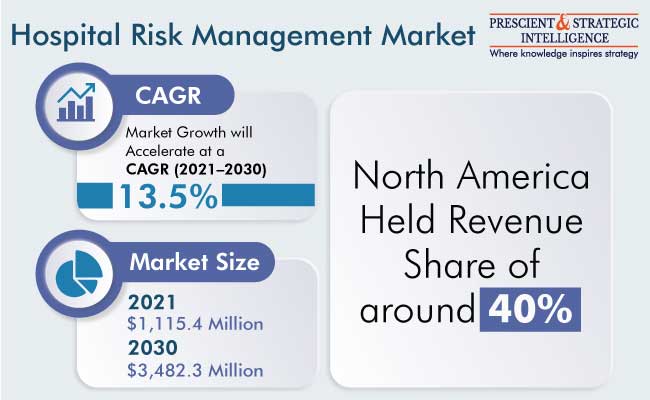Why Will Large Hospitals Drive Hospital Risk Management Market?
The major drivers in the global hospital risk management market are the high prevalence of long-term diseases and the increasing count of medical errors. In 2021, the market was valued at $1,115.4 million, and it is projected to touch $3,482.3 million by 2030. The market will advance at a 13.5% CAGR from 2021 to 2030. Medical errors lead to approximately 3 million deaths every year in comparison to mortality from malaria, HIV, and tuberculosis. Furthermore, extensive governmental support, the increasing integration of information technology in hospitals and clinics, and swift modernization will drive the market.
Based on type, the category projected to advance at the largest CAGR in the hospital risk management market in the forecast period, of about 14%, is risk and compliance management. This can be attributed to the increasing prevalence of hospital-acquired infection, the dire need to lessen the costs of healthcare and increasing awareness of the safety concerns of patients. There was an at least 15% rise in hospital-onset methicillin-resistant Staphylococcus aureus (MRSA) infection and a 25% spike in the count of central line-associated bloodstream infections (CLABSI) in 2020 generating a snowballing demand for risk and compliance management software.
Furthermore, the second-largest shareholder in the hospital risk management market is the workflow management category, accounting for about one-fifth of the total revenue, in 2021. There is huge pressure on the healthcare infrastructure because of the surging incidence of long-term illnesses. Around 70% of the global deaths are because of chronic diseases per year, accounting for approximately the death of 40 million people each year. Apart from offering better effectiveness in medical data control, the category improves internal operations via automation.
Within the deployment segment, the hospital risk management market is bifurcated into the on-premises and cloud-based categories. In 2021, the cloud-based category held a bigger revenue share, of about 80% of the sales revenue, and it is predicted to exhibit the same trend in the forecast period as well by advancing at a 14.0% CAGR in the coming years. This can be credited to minimizing operational costs, coupled with a snowballing demand to trade data among several applications and databases and to promote interoperability within several corporations and healthcare centers and corporations.
By 2030, the biggest share in the hospital risk management market will be held by the large hospital category, accounting for approximately 60% of the total market share. This can be ascribed to a swift integration of EHRs in the healthcare centers., surging hospital expenditure, and an increasing count of large hospitals. To remove the medical errors, there is a dire need for hospital risk management to enhance the operations of EHR systems. The highest hospital bed density is witnessed in Japan with approximately 13 beds for every 1000 people.
In 2021, the global hospital risk management market was led by North America. This is because of the surging adoption of data science to ease the workflow in healthcare centers, the paradigm shift of the on-premises risk management to cloud-based solutions, and the surging count of market players in the U.S. There is a high investment in the healthcare sector due to rising medical errors. Approximately $40 billion is spent on patients bothered with medication errors.
Hence, an increasing count of medical errors and a high prevalence of long-term diseases will provide lucrative opportunities to the market players to gain a competitive edge.
Read More: https://www.psmarketresearch.c....om/market-analysis/h
